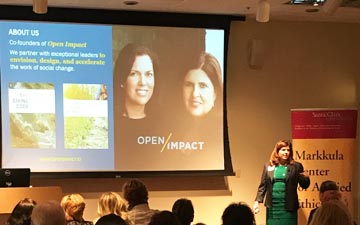
Guiding New Donors to Actualized Philanthropy at the Markkula Center
Open Impact recently released The Giving Journey, a report on what motivates ultra-wealthy Silicon Valley donors to give. The report identified five key phases during a donor’s journey:
- Formative Experiences
Donors eventually give based on personal experiences they had growing up. Their giving choices are informed by early childhood experiences, parents, faith, and family background, and are grounded in values. - Wealth Event and Pause
Open Impact found that there tends to be a 5 to10-year delay between an ultra-wealthy donor’s wealth event (like an IPO) and giving. During that 5 to10-year time, these donors are starting to think about how much money they need to support themselves and their families. Then they move on to figuring out other ways to allocate their money. - Getting Unstuck
Donors will start their philanthropic journeys by giving to what is familiar to them, such as private schools, hospitals, etc. - Ramping Up
They begin to look outside their comfort zones and become more strategic about giving. First, they turn to their peer group and their networks to see where they’re giving. - Actualized Philanthropy
Then they focus on impact and innovation, and they start to approach philanthropy as they approach their investment portfolio.
During a talk on May 18, 2018 at the Markkula Center, Heather McLeod Grant, co-author of The Giving Code and The Giving Journey and co-founder of Open Impact, talked about the five phases of giving, and she also gave nonprofits insight into how ultra-wealthy donors decide to give. One key takeaway was that executives and donors do not read pages of documents anymore, and instead, each nonprofit should have a pitch deck to appeal to donors. For details on McLeod Grant’s “10 core elements of a pitch deck,” please see the event video and slide deck.
McLeod Grant also emphasized that nonprofits should use the language of business to appeal to wealthy donors. For example, one nonprofit in San Francisco now holds monthly investor calls for any corporation or individual that donates to their organization. These have been hugely successful because the donors appreciate the quick and frequent access to information. Overall, while there are gaps between donors and nonprofits in Silicon Valley, many younger, ultra-wealthy donors are ramping up to give, so now is the time for nonprofits to think with a business mind to best appeal to these donors.
